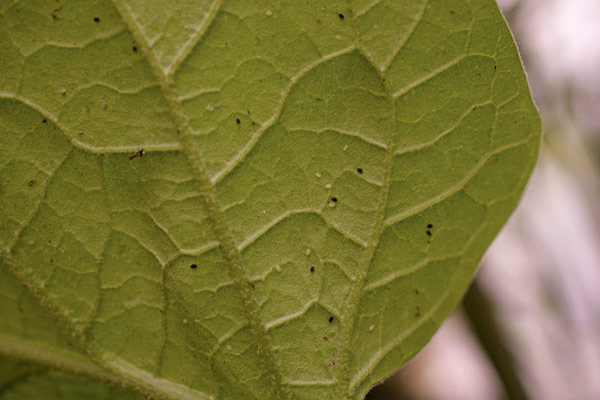Guardians of the Greenhouse
Plants Trap Pests and Shelter Beneficial Insects
 |
|
On this eggplant leaf, immature whiteflies have been killed by Encarsia formosa, a tiny parasitic wasp. Whitefly nymphs gradually turn black as new parasitic wasps mature inside them. Photo by Michelle Ten Eyck. |
Greenhouses extend the growing season and increase profits for northeastern growers, but they also create ideal conditions for pest outbreaks. With funds from the Northeastern IPM Center, Carol Glenister (IPM Laboratories) worked with University of Vermont entomologists Margaret Skinner and Cheryl Frank to develop strategies for using “guardian plants” to manage greenhouse pests with little or no pesticide. Guardian plants pull pests away from the crops and sustain beneficial insects that control the pests.
Eggplants are an excellent guardian plant against whiteflies on poinsettias and annual flowers. The eggplants attract whiteflies away from the crop. They also provide a habitat for tiny beneficial wasps that are released in the greenhouse to feed on, and lay eggs in, immature whiteflies. If the pest–beneficial balance swings too far toward the pests, management like sprays or vacuuming can be targeted at whiteflies on the guardian plants.
In 75 percent of Glenister’s guardian plant trials, the number of pesticide treatments was lower compared to controls. At one Vermont site, a grower who formerly used one or more insecticides per year to control whiteflies on his crop did not use any insecticide treatments at all in 2007 and 2008. The use of guardian plants also saved time, as IPM scouts could more efficiently detect whiteflies and their natural enemies on the guardian plants. Ongoing studies have identified other potential guardian plants that are effective with specific pests: lantana for whitefly control; marigolds or black pearl ornamental pepper for thrips control.
Guardian plants have substantially enhanced grower confidence in biological control by reducing monitoring time and decreasing costs, both of which can add up to greater profitability. To expand the use of such systems, Glenister is launching a website where grower’s observations can be recorded, shared, and used to help others learn about guardian plant development.
Learn more about Glenister’s projects by searching the Northeastern IPM Center’s project database. The Northeastern IPM Center encourages integrated pest management for reducing risks to human health and the environment.
